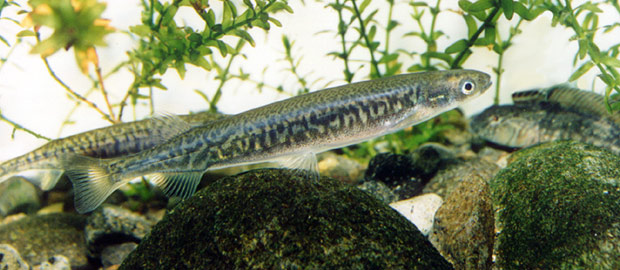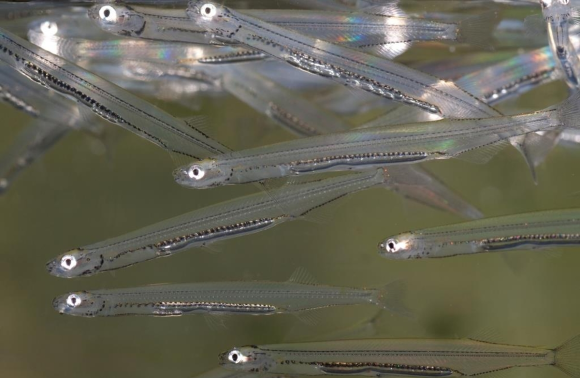Whitebait
During the months of August to November visitors to the streams around Pāuatahanui Inlet will see several people perched on the banks, eyes focused on the water. What they are keenly hoping for is a large catch of small freshwater fish that are being carried upstream in shoals on the incoming tide. These are the young of several species of fish which many people regard as a delicacy. Known collectively as whitebait they are cooked in various recipes, the best known of these being fritters.

New Zealand has around 40 native freshwater fish species and about half of them spend part of their lives at sea. Most NZ species, 25 according to some sources, belong to just one group known as the galaxiids. These fish have no scales and are so named because of the markings on their skin, which have been likened to a galaxy of stars.
All but five galaxiid species don’t migrate, but the five that do develop as larvae in the ocean making up part of the zooplankton. They return to the rivers to spend all their adult life in fresh water. It is the juveniles of these five galaxiid species that make up New Zealand’s whitebait catch.
While the five species that make up whitebait are all found in New Zealand waters only three species have been recorded in Pāuatahanui Inlet streams (with a possible fourth, the kōaro, yet to be confirmed).
The majority of the whitebait catch consists of the very widely distributed Galaxias maculatus or inanga.
A much smaller percentage are Galaxias argenteus (the endangered giant kōkopu) and Galaxias fasciatus (the banded kōkopu).
Inanga are the smallest of the species, rarely exceeding 110mm in length, but the one whose life cycle is most fully understood.
Inanga
Found in places as far flung as Chile, Argentina and Australia, G. maculatus is the most widely distributed native freshwater fish in the world. It is also the shortest lived of the whitebait species.
Inanga, the New Zealand name, inhabit lowland slow-moving streams within a short distance of the sea and are poor climbers, avoiding waterfalls or steep gradients. Swimming together in shoals the adults feed on aquatic and terrestrial insects and crustaceans. Together they migrate downstream to the estuaries during the extra-high spring tides of autumn and spawn on overhanging fringing vegetation within the estuarine boundary. Many adults die after spawning and those that survive the first year will die after the second.
The eggs develop out of water, above the normal high tide limit, until the next spring tide occurs, two to four weeks later. On re-submersion the eggs hatch and the larvae are carried out to sea by the outgoing tide. Here they spend 5-6 months as plankton feeders before returning during spring (not always to the same river) as shoals of 50mm-long whitebait. The translucent juveniles swim against the river’s flow, keeping near the edge where the current is weakest.
It is at this stage that the whitebaiters sit in wait for them.
If they manage to escape being caught they spend the rest of their lives maturing into adults higher up the river before the migration begins again the following autumn.

Of the other two species, adult banded kōkopu have numerous pale stripes across the body and can grow up to 26cm long. Unlike inanga they are good climbers and make their way well upriver until they find small forest streams with plenty of cover and shade. Like other galaxiids, banded kōkopu have sensors on their heads to detect when and where something hits the water, enabling them to feed on insects that fall from overhanging plants.
The giant kōkopu is a secretive species and loves having plenty of cover to hide under, preferring gently flowing overgrown streams, swampy lagoons and lake edges. It is a skulking predator, lurking under cover and making speedy dashes to nab its prey. Both banded kōkopu and giant kōkopu are also incorrectly called native or Māori trout.
Each species of whitebait has particular areas for spawning and in July 2001 Wellington Regional Council undertook a survey to identify inanga spawning locations. The survey found several spawning areas in the rivers and streams entering Pāuatahanui Inlet. In Duck Creek it was an area of tall fescue, toetoe and flax overhanging the stream. This was prior to the development of housing along the river’s floodplain. At Pāuatahanui a new bridge was being constructed over the stream and two nearby areas were identified with tall fescue, toetoe, blackberry and mint. The Horokiri stream was found to be an unlikely spawning area due to grazing and removal of riparian vegetation, and there was no likely area on the Kakaho stream due to mechanical grading of the riverbanks. So locations for spawning were seen to be limited and an education programme was set up to help improve the situation. A lot has happened since then in most locations but we are not aware of any more recent surveys undertaken to establish the current condition of these spawning sites.
The Whitebait Season
Whitebaiting in New Zealand is a seasonal activity only entered into during the spring migration of whitebait upstream. But all the species of galaxiid are declining in numbers as demonstrated by falling catch quantities year-on-year.
For this reason there is a fixed, limited and legally enforced period of time when the juveniles are allowed to be netted. There is strict control over net sizes and there are rules against blocking the river to channel the fish into the net. This is all aimed at allowing sufficient quantity of whitebait to reach the adult habitat and maintain stock levels.
And one other point of interest
The term ‘Whitebait’ is not just a New Zealand name but one used in other parts of the world as a general description for the immature fry of many important food fish species such as herring, sprat, sardines, mackerel, bass and others. In England whitebait is mostly fully-marine Clupeidae fish, mainly herring. These are much larger than the New Zealand galaxiid species. In New Zealand another species of juvenile fish, the common smelt is also caught as whitebait.